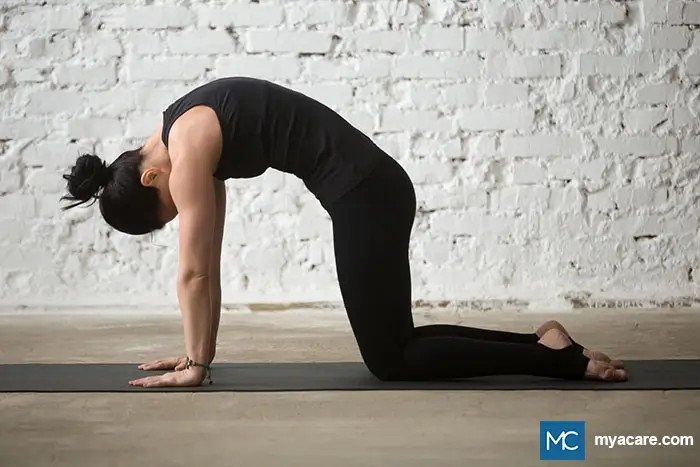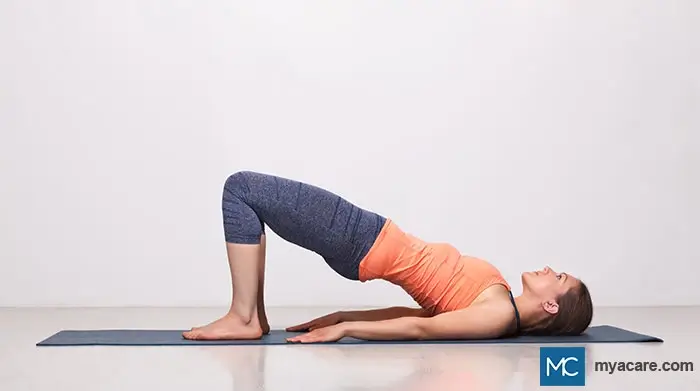Unlocking the Secrets of Good Posture for a Pain-Free Neck

Medically Reviewed by Dr. Sony Sherpa, (MBBS) - August 19, 2024
How Poor Posture Leads to Neck Pain
Exercises for Bad Posture that Relieve Neck Pain
Have you ever felt constant pain in your neck after a long day? If so, you might be suffering from the effects of bad posture. When your posture is not correct, it stresses and strains on your muscles, joints, and spine. Poor posture can adversely affect your overall health by reducing blood circulation, detracting from breathing, affecting digestion, and lowering mood and energy. As the neck rests at the top of the spine and relies on everything below it for support, bad posture can also lead to neck pain.
Maintaining a good posture is essential for preventing neck pain and avoiding many of the above health issues. In this article, we will discuss the link between posture, neck pain, and other symptoms and how to fix bad neck posture.
How Poor Posture Can Lead to Neck Pain
Your neck is designed to be in a neutral position, where the spine is straight, the shoulders rest back, and both ears are in alignment with your shoulders. This position allows your neck to support the weight of your head without taking strain.
Signs that one’s posture is bad include slouching, a forward head tilt, or rounding the shoulders. These are bound to cause neck pain if left uncorrected for a long period. Aging, sitting for long periods of time, and using electronic devices can all detract from neck posture.
Poor posture can lead to the following scenarios that can cause neck pain and perpetuate bad posture[1]:
- Neck strain - resulting in pain, stiffness, swelling, and a reduced range of motion.
- Muscle imbalances - due to bad posture when some muscles in the neck become unevenly tight or weak and others become loose or strong. This reduces neck muscle stability.
- Disc compression - when the discs or joints in your neck are squeezed or pinched, leading to inflammation, degeneration, and neck pain.
- Lowered flexibility - due to stiff and weakened muscles.
- Nerve impingement - when a nerve is compressed due to disc herniation, potentially leading to pain, numbness, tingling, or weakness in the neck or other parts of the body.
Neck pain aside, bad posture can also cause back pain, headaches, migraines, and exacerbate overall body pain, especially for those who suffer from inflammatory conditions like arthritis.[2] In the long run, bad neck posture can lead to lower mobility and a greatly reduced quality of life.
Causes of Bad Posture
The most common causes of bad neck posture include:
- Leading a sedentary lifestyle
- Poorly designed seats and tables that detract from posture (bad ergonomics)
- Improper sleeping position and pillow usage
- Muscle imbalances and weakness
- Stress and anxiety
All of these factors detract from posture by causing the spine to go out of alignment on a continuous basis. This trains and/or weakens the core muscles responsible for maintaining good posture and can lead to neck pain due to heightened muscle stiffness as well.
Exercises for Bad Posture that Relieve Neck Pain
One of the best ways to improve your posture and relieve neck pain is to practice daily exercises that target the muscles involved. These can help you to:
- Stretch tight muscles in your neck, upper back, and shoulders to improve flexibility and mobility.
- Strengthen weak and overstretched muscles for improved stability and function.
- Work the core muscles in the body to provide a solid foundation for good posture.
- Improve neck posture and reduce neck pain, as seen in some studies[3].
Some examples of exercises that can help you improve your posture and relieve neck pain are:
Chin Tucks
These retract the chin to strengthen the muscles at the front of the neck. To perform this exercise, sit or stand with a neutral spine and look straight ahead. Slowly pull your chin back as if you are making a double chin without tilting your head up or down. Hold for a few seconds, and then relax. Repeat 10 times.
Upper Back Stretches
Exercises like cat-cow or thoracic rotations work the upper back muscles and increase their flexibility. To perform cat-cow, start on your hands and knees with a neutral spine. Inhale and arch your back, lifting your chest and tailbone up. Exhale and round your back, tucking in your chin and tailbone. Repeat 10 times.

For thoracic rotations, start on your hands and knees with a neutral spine. Place one hand behind your head and rotate your torso to the same side, opening your chest and elbow up. Return to the center and switch sides. Repeat 10 times on each side.
Shoulder Blade Squeeze
Simple shoulder blade presses can help to strengthen your neck posture. Sit or stand with a neutral spine and relax your shoulders. Bring your shoulder blades together as if you are attempting to hold a pencil between them. Hold for a few seconds, and then release. Repeat 10 times.

Plank Variations
Engage the core muscles for a strong and stable foundation. To perform a plank, start on your hands and knees with a neutral spine. Extend your legs behind you and balance on your toes and palms, keeping your body in a straight line from head to heels. Engage your core and glutes while avoiding sagging or arching your back. Hold for as long as you can, starting from 10 seconds and gradually increasing. You can also perform plank variations such as side planks, elbow planks, or knee planks to challenge yourself.

Bridge Pose
Strengthen the lower back to support the spine. To perform this exercise, lie on your back with your knees bent and feet flat on the floor. Lift your hips up until your body forms a straight line from shoulders to knees. Squeeze your glutes and avoid overextending your lower back. Hold for a few seconds and then lower down. Repeat 10 times.

4 Extra Tips for Better Posture
In addition to performing exercises, you can also follow these tips to improve your posture in daily life:
- Use Proper Ergonomics. Adjust your workstation, chair, desk, keyboard, mouse, monitor, phone, tablet, or TV to suit your posture, height, size, and comfort level. Make sure that you have enough space and support for your body. For more information on Office Ergonomics, please visit this article.
- Regular Physical Breaks. Avoid staying in one position for too long, whether sitting, standing, or lying down. Take frequent breaks every 20 to 30 minutes where you change your posture, stretch, walk, or do some physical activity. This can help prevent stiffness, fatigue, and pain in the neck and body.
- Use Supportive Pillows. Use pillows that are appropriate for your sleeping position and head and neck size. Avoid using too many or too few pillows that can cause misalignment or pressure on your neck. You can also use ergonomic accessories such as lumbar cushions, footrests, wrist rests, or neck pillows to provide extra support and comfort for your posture.
- Develop Body Awareness. Pay attention to how you hold yourself throughout the day and notice any signs of poor posture, such as slouching, forward head posture, rounded shoulders, or neck pain. Correct bad posture as soon as you notice it. Studies suggest that walking or running may promote a forward head tilt, suggesting that being mindful of the neck during these activities can help[4]. Cues through mirrors, reminders, or feedback from others can all help.
When to See a Doctor for Neck Pain
If you experience unrelenting or severe neck pain due to bad posture, you may benefit from seeking professional help. A qualified physician can take a closer look at the underlying cause of neck pain and offer prescription medications or steroid injections to manage severe pain.[5]
It may be useful to consult a physical therapist or chiropractor to provide advice on neck muscle-building exercises and to help you get your neck and back into an optimal alignment.
Conclusion
Your posture has an impact on your overall well-being. Bad posture can lead to neck pain and other problems due to muscle strain, joint compression, nerve impingement, and reduced flexibility. To prevent these issues, you can practice good posture by doing exercises that stretch and strengthen your neck, upper back, shoulders, and core. Proper ergonomics, moving regularly, using supportive pillows, and being mindful of your body alignment are all helpful for maintaining better neck posture.
Good posture can help you avoid neck pain and improve the quality of your life. Do not ignore neck pain that does not go away, and seek medical attention. The neck is an important part of your body that deserves the best possible care.
To search for the best Orthopedic Doctors in Germany, India, Malaysia, Spain, Thailand, the UAE, the UK and the USA, please use the Mya Care search engine.
To search for the best Orthopedic Healthcare Providers in Croatia, Germany, India, Malaysia, Singapore, Spain, Thailand, Turkey, the UAE, UK and the USA, please use the Mya Care search engine.
To search for the best doctors and healthcare providers worldwide, please use the Mya Care search engine.
The Mya Care Editorial Team comprises medical doctors and qualified professionals with a background in healthcare, dedicated to delivering trustworthy, evidence-based health content.
Our team draws on authoritative sources, including systematic reviews published in top-tier medical journals, the latest academic and professional books by renowned experts, and official guidelines from authoritative global health organizations. This rigorous process ensures every article reflects current medical standards and is regularly updated to include the latest healthcare insights.

Dr. Sony Sherpa completed her MBBS at Guangzhou Medical University, China. She is a resident doctor, researcher, and medical writer who believes in the importance of accessible, quality healthcare for everyone. Her work in the healthcare field is focused on improving the well-being of individuals and communities, ensuring they receive the necessary care and support for a healthy and fulfilling life.
Sources:
Featured Blogs



